![]()
![]()
![]()
Use LEFT and RIGHT arrow keys to navigate between flashcards;
Use UP and DOWN arrow keys to flip the card;
H to show hint;
A reads text to speech;
27 Cards in this Set
- Front
- Back
|
IMPRESSIONISM
|
Movement in the late 19th century, part of the Avant Garde movement (impressionism and post impressionism)
Always presented work publicly as a group. First to present outside of a royal presentation. Painted real life much like realists, but different because impressionists sought to capture a moment or impression. Paintings were an individual experience. Loved painting water because it presented a challenge painted quickly and outside paintings were sketchy, blurry, and showed brushstrokes, which went against painting basics for that time. |
|

Claude Monet, Boulevard des Capucines, Paris, 1873.
|
Impressionism
don't see people as individuals, Monet is new to Paris and wants to capture this Paris is undergoing development and changing, the blurriness shows the transitory state the city was in |
|
|
POST IMPRESSIONISM
|
Re-imagining of impressionism, concerned that perhaps impressionism was too momentary, wasn't meaningful or lasting
|
|
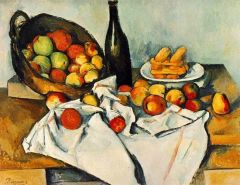
Paul Cézanne, Still Life with Basket of Apples, 1895.
|
Post-Impressionism
Capture the process of painting, embraces awkwardness, without art tricks, painting took awhile so his shifts in structure made the painting look choppy and he kept it like that tried to show the true experience of sight: moving and discovering as we see - thats why the table is crooked and the cookies look distorted |
|
|
MODERNISM
|
Movement in which the artists understand that what they're doing is fiction. Modernism is about self-awarness, and they manipulate paintings to convey a new sensation.
|
|
|
FAUVISM
|
Sub-movement of Modernism
Fauvism is deliberately trying to create revolutionary style like the impressionists. Fauvists showed stroke lines, which went against traditional technique. They believed in 'honest expression.' Got its name after being dubbed "Les Fauves" or "Wild Beasts" at the first event in 20th century art, an exhibition headed by Henri Matisse who showed works that broke traditional standards, like color. The Fauves freed color from it's traditional descriptive role, using it as an expressive end in itself, often called 'deliberate disharmonies.' |
|
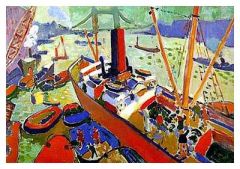
André Derain, The Pool of London, 1906.
|
All naturalistic effects for color are abandoned, and the use of 'deliberate disharmonies' of color create an expressive emotional reaction to the subject Derain is painting. Gives the sensation of a busy port, things are outlined in big thick black lines, which is almost childish. Exemplary of Fauvism for it's use of color and breaking the traditional color descriptive mode.
|
|
|
CUBISM
|
Sub-movement of modernism
focus on the analysis of the real world and breakdown of reality into smaller sections - abstraction as a conscious and serious issue. "it is an art dealing primarily with forms and when a form is realized it is there to live its own life." - Picasso, 1923 |
|
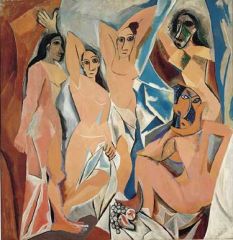
Pablo Picasso, Les Demoiselles d'Avignon, 1907.
|
Cubism
Named after the red-light district in Picasso's hometown. depicts five prostitutes, mean it to create a moralistic point of view - makes the painting about us as a viewer and our morals. Fruit is typically shown as soft and round, with women, associating them with delicateness and softness. Here the fruit is weaponlike, sharp and dangerous. This underscores his ideas of the dangers of women, maybe the dangers of these prostitutes, and their crudeness. Instead of treating the picture as a window opening onto the visible 3d world, he saw it simply as a painting, as a complex of invented forms, flat or nearly so. Re-ordered human images to geometric shapes, which makes it revolutionary, opening up new approaches to the treatment of space and form and to the evocation of previously unexpressed emotions and states of mind, like the rejection of all the comfortable, contrived coherences of representational art. More of a ravening eroticism than the sensual eroticism of previous paintings, like the Turkish Bath by Ingres. |
|
|
FUTURISM
|
Sub-movement of modernism
Not concerned solely with the arts, less of a style than an ideology created by Italian poet Emilio Marinetti and launched globally with the publication of the Futurist Manifesto. Sought to destroy the old and replace it with new society and art based on new dynamic sensations. Many Futurists were war-hungry, and eagerly answered their country's call for soldiers during WW1, and many died on the battlefield. Affected many of the following European contemporary arts movements, even in just the slightest way. |
|

Umberto Boccioni, Unique Forms of Continuity in Space, 1913.
|
Futurism
Breaks down what we think of as figures and space; it's about movement and the figure steps forward with a surge of energy, similar to the Victory of Samothrace. Does not symbolize the movement but realize it through a sequence of surfaces which seem to be constantly dissolving and reforming. He achieved what he sought - "not pure form, but pure plastic rhythm; not the construction of the body, but the construction of the action of the body." |
|
|
DADA
|
Sub movement of modernism
State of mind rather than a literary or artistic movement Mocked all established values, traditional notions on good taste in art and literature. denied even the value of art, cult of non-art. Name itself is nonsensical, a baby talk word, or a word that has a variety of meanings in different languages. |
|
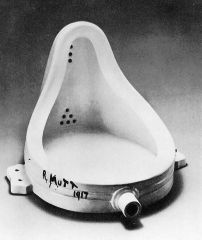
Marcel Duchamp, Fountain, 1917.
|
Dada
A ready-made, as in, an ordinary object that forces aesthetic questions to contemplate onto the viewer. Ready-mades were everyday manufactured items converted into works of art simply by the artist's act of choosing them. Changed the context it was in, no longer plumbing, but art. Duchamp did nothing to them except present them for contemplation as art, and Fountain was anonymously entered into an art showing for anyone who paid the small fee to show their work. Duchamp was on the board of advisors for this event, and wanted to see their reactions. |
|
|
POST WAR
|
Fracturing of styles, less definitive movements
|
|
|
SURREALISM
|
Sub movement of Postwar art
Anti-rational, attempt to get to the subconsciousness, to a level of creation not controlled by the artist. Inspired by the beginning use of psychology and psychoanalysis in the treatment of PSTD for soldiers. Not about controlling the painting or where it's going, just letting the painting develop with the subconscious. |
|

Max Ernst, Two Children are Menaced by a Nightingale, 1924.
|
Surrealism
Functions like a dream state - the scale and strong juxtapositioning. Creepy figure holding a baby on top of the shed, reaching for a doorknob - to the real world? Young girl holding a huge knife, weird figure sprawled on the ground. Tiny bird over in the left hand side, seems to have no importance to us. |
|
|
ABSTRACT EXPRESSIONISM
|
Sub movement of Postwar art
No definite style, but all believed to be in the same human predicament of being Americans in the complex aftermath of WW2. Instead of reproducing, redesigning, analyseing, or expressing an object, real or imagined, abstract expressionists final pieces were the result of the encounter between the artist, the medium, and the canvas. |
|
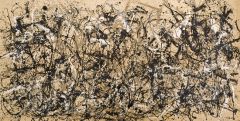
Jackson Pollock, Autumn Rhythm, 1950.
|
Abstract Expressionism
Pollock struggled with traditional techniques of painting, making the act of trying to paint it's own subject. Canvas was rolled out onto the floor, and paint splatters simply recorded his engagement with the medium as he walked around the canvas and sometimes through it, which he believed brought him closer to his painting. Controlled his movements and the flow of the paint so there was no accident. |
|
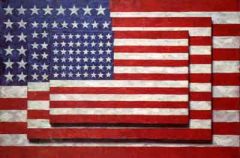
Jasper Johns, Three Flags, 1958.
|
Neo-Dada
Created with encaustic, a very old technique using dripping wax. Used symbols we take for granted, like the American flag or a target symbol, because it's depersonalized, and showing it differently. Is it a layering of three flags? Three paintings of flags? Is it a new flag? Is Johns mocking the flag or art? |
|
|
POP ART
|
Sub-movement of Post War art
making impersonality a style by using the imagery of commercial art and other mass media sources |
|
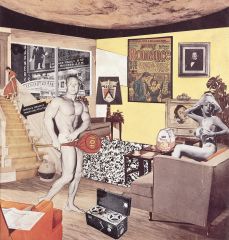
Richard Hamilton, Just what is it that makes today's homes, so different, so appealing?, 1956.
|
Pop Art
Misconstrued as an attack on art or the consumer society, Hamilton said he was aiming at new art that would be popular, low cost, young, and big business. However, the imagery was banal for Americans, and glamorous for Europeans. |
|
|
EARTH ART
|
Sub movement of Postwar art
Landscape seen as one of the most powerful national metaphors as an artistic subject in the USA, and now became a medium of artistic expression and led to complete transformations of the natural physical world. |
|
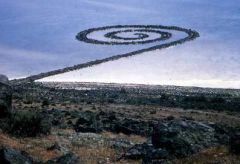
Robert Smithson, Spiral Jetty, 1970.
|
Earth Art
Generated by the artist's American response to landscape. When he saw the site, he saw an endless cyclone, a complex lattice work of spirals, so he created a large spiral to link the rest of nature together, and to promote the idea that art should not be thought of in terms of one object. |
|
|
POLITICAL/IDENTITY
|
Sub movement of Postwar art
Used art as a medium of challenging social norms of identity or as a political statement |
|
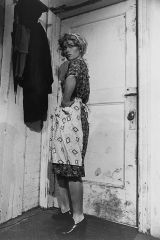
Cindy Sherman, Untitled Film Still, 1980.
|
Political/Identity
The title suggest a narrative, and because of that viewers create a backstory and make assumptions based on the surroundings and clothes. Sherman created masks of herself based on current myths, stereotypes, and media images of women. By mocking photographic scenarios, she makes us aware that these are not just images of women but also signs of difference, markers or templates of masculinity- since women are trying to create 'femininity', they are deliberately avoiding masculine concepts and therefore eluding their true selves. |
|
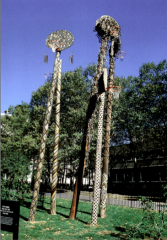
David Hammons, Higher Goals, 1986.
|
Political/Identity
Hammons built this structure in the midst of the projects, where many kids believe that they can get out of poverty by becoming basketball stars. Higher Goals meant to inspire them to seek other aspirations and not limit themselves to basketball - because not everyone gets to be an NBA star. |
|
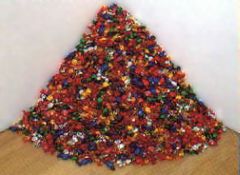
Felix Gonzalez-Torres, Untitled (Portrait of Ross in LA), 1991.
|
Political/Identity
Created as a memorial to his partner, Ross, who died because of HIV/AIDS related complications. It's 195 lbs of candy, piled up, and viewers are encouraged to take a piece. 195 lbs was Ross at his healthy weight, and the piece celebrates Ross's life with candy - passing on the joy his life held for Gonzalez-Torres, and it's up to the viewer to save the candy, or eat it. It also depicts Ross's transformation from a healthy weight, dwindling down until his death. Then, the next day, the pile of candy is replenished. |

